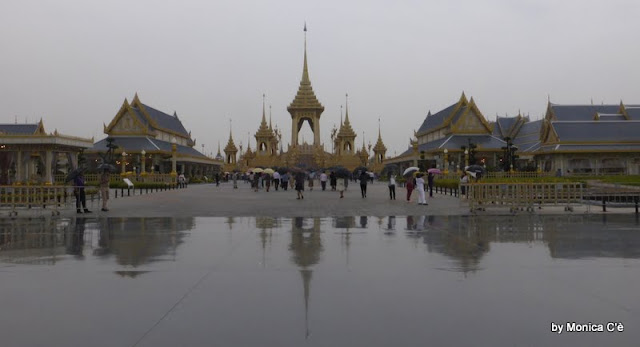[SCROLL DOWN FOR ENGLISH]
La visionarietà dei templi bianco e blu costituisce un polo di attrazione turistica di indubbio valore. Ma Chiang Rai non finisce di stupire e merita senz'altro una visita il tempio di Huay Plakang in cui si manifesta tutto il bisogno di gigantismo statutario della cultura buddista anche di corrente cinese. Questo complesso rimane a qualche chilometro di distanza dal centro di Chiang Rai ma visibile appunto anche da qui. Il complesso è costituito da due templi, una straordinaria pagoda a nove piani
e un tempio invece nel più classico stile theravada anche questo completamente bianco nelle pareti e decorazioni interne e esterne. Ma l'elemento più strabiliante è la statua della divinità femminile Guanyin, alta come un palazzo di 23 piani, con tanto di ascensore interno che vi porta all'interno della sua testa consentendo di avere la visuale dai suoi occhi compreso il terzo.
 |
| Vista dal terzo occhio |
L'accesso alla statua è enfatizzato da una enorme scalinata a cui fanno guardia ben sei enormi draghi bianchi dagli occhi colorati.
Ovviamente ci si sente infinitamente piccoli ai piedi di questa gigantesca statua ma apre il cuore sapere che Guanyin rappresenta un essere femminile che soccorre quanti chiedono aiuto. Ha sempre un'espressione serena e nelle mani ha un vaso con l'acqua come elemento di purificazione.A causa delle dimensioni la statua del Huay Plakang è visibile anche a chilometri di distanza e questa foto l'ho scattata dal wat phra that doi tung, in centro a Chiang Rai ovvero da circa sei chilometri.
La pagoda custodisce all'interno una serie notevolissima di statue lignee, molte raffiguranti sempre Guanyin.
Ammetto però di non essere andata oltre il terzo piano, perchè in questa struttura non c'è ascensore e i nove piani eventualmente vanno saliti tutti a piedi.
Di fianco alla pagoda è collocato il tempio in stile thai le cui dimensioni sembrano ancora più modeste trovandosi tra il manufatto da 23 piani e l'altro da nove piani.
In città ho visitato il tempio phra that doi thong che si trova su una piccola collina e ospita una antica reliquia precedente alla costruzione della città all'interno di un chedi alto circa 14 metri.
Nelle immediate vicinanze del tempio, sempre sulla collina è collocato il pilastro della città, in una struttura geometrica realizzata nel 1987 nella ricorrenza dei sessanta anni di re Bhumipol e del 725° anno di fondazione della città.
Album con tutte le foto scattate a Chiang rai
[ENGLISH VERSION]
The visionary nature of the white and blue temples is a tourist attraction of undoubted value. But Chiang Rai doesn't stop to amaze and the temple of Huay Plakang is certainly worth a visit, where all the need for statuary gigantism of Buddhist culture, even of the Chinese current, is manifested. This complex remains a few kilometers away from the center of Chiang Rai but also visible from here. The complex consists of two temples, an extraordinary nine-storey pagoda and a temple in the more classical Theravada style, which is also completely white in its walls and internal and external decorations.
But the most amazing element is the statue of the female deity Guanyin, as tall as a building of 23 floors, with an internal lift that takes you inside his head allowing you to have the view from his eyes including the third.
The access to the statue is emphasized by a huge staircase which is guarded by six huge white dragons with colorful eyes.
Obviously you feel infinitely small at the foot of this giant statue but it opens your heart to know that Guanyin is a female being who helps those who ask for help. He always has a serene expression and in his hands he has a vase with water as an element of purification.
Because of its size, the statue of Huay Plakang is visible even from miles away and I took this picture from the wat phra that doi tung, in the center of Chiang Rai or about six kilometers.
The pagoda houses inside a remarkable series of wooden statues, many of them depicting Guanyin.
I admit, however, that I did not go beyond the third floor, because in this structure there is no elevator and the nine floors eventually have to be climbed all on foot.
Next to the pagoda is the temple in Thai style whose dimensions seem even more modest being between the building of 23 floors and the other of nine floors.
In the city I visited the temple phra that doi thong which is located on a small hill and houses an ancient relic before the construction of the city within a chedi about 14 meters high.
In the immediate vicinity of the temple, always on the hill is located the pillar of the city, in a geometric structure built in 1987 on the occasion of the sixty years of King Bhumipol and the 725th year of foundation of the city.























































